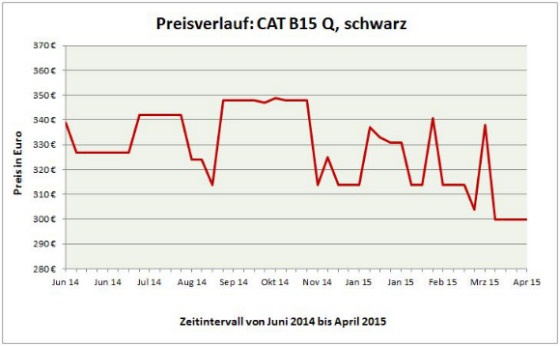Languages
Contact
CONTACT - 0049 9133 7770-800
Price roller coaster and regularly changing prices

Marcus Brendl, Director Hardware
The larger the marketplace becomes, the more factors influence the price, and e-commerce retailers on the internet can react in a matter of minutes. Thanks to mobile internet, however, prices in store are now in competition with prices offered online, making it necessary for new prices to be calculated in store on an ongoing basis. Prices are starting to move, like share prices on the stock exchange. For the latest products, it is not unusual for the price to even change several times a minute! Look for example how online prices progressed for the CAT B15 Q. These fluctuations make it clear that prices need to be checked at least once a day.

That is much more complicated than you might think. Prices on the most important websites have to be checked continuously and then taken as the basis for determining the new price. Within our brodos.net platform, this function is incorporated into StoreShip and we publish the recommended retail price for brick and mortar retailers as the “StoreShip RRP”. For our StoreShip price we look into the offers available on the large internet shopping platforms, price search engines and from online retailers. We rate these according to their relevance to determine a fair internet price. We then compare this with the prices from our suppliers, in order to display the best possible offer. This ensures that the StoreShip price is always a fair price for end customers whilst at the same time guaranteeing a margin for the retailer.
Up to date prices at all times in the Connected Store
Adjusting prices is no problem in our brodos.net Kiosk and online Kiosk, as the prices are controlled centrally and brought up to date automatically. The Kiosk basically acts as a large digital price tag for all products in the brodos.net marketplace.
Media Markt and Rewe are pioneers in the field of electronically controlled price tags. They know that purchasing behaviour is set to change dramatically and that customers will use their mobile devices to compare prices in store. If the product has the wrong price, the brick and mortar retailer will miss out. Logically, head office should be able to change prices at the press of a button.
I am sure that once the infrastructure has been installed we will be surprised with several applications for dynamic labelling unlike anything we have seen to date. For example, prices for perishable goods could be reduced the nearer the product comes to its use by date. It is also possible that special offers could be made or prices in general reduced in periods with low customer traffic. A kind of happy hour in the supermarket. Petrol stations could now not only increase fuel prices at the weekend, but also, for example, charge other prices at night when all other stores are shut compared to during the day when they are in competition with supermarkets.
Monday, 11. May 2015 -13:15
COMMENTS































